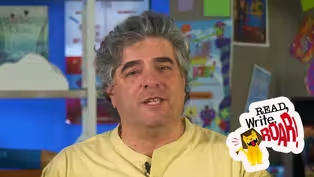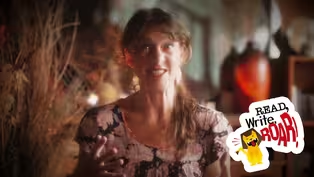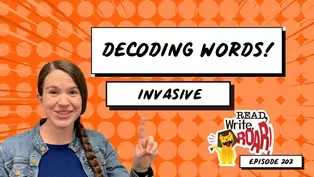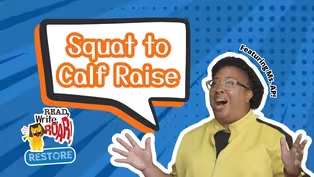Read, Write, ROAR!
Bloom Boom: Algae Impact | Sequencing for Grades 4-5
Clip: Season 1 Episode 1019 | 6m 45sVideo has Closed Captions
Dive into the world of algae and explore how human actions cause harmful algal blooms.
Did you know your backyard choices can affect Lake Erie miles away? Join Mr. Peterson as he dives into the world of algae and explores how human actions cause harmful algal blooms. Learn about eutrophication, the impact on wildlife, and how you can make a positive environmental change!
Problems playing video? | Closed Captioning Feedback
Problems playing video? | Closed Captioning Feedback
Read, Write, ROAR! is a local public television program presented by Detroit PBS
Read, Write, ROAR!
Bloom Boom: Algae Impact | Sequencing for Grades 4-5
Clip: Season 1 Episode 1019 | 6m 45sVideo has Closed Captions
Did you know your backyard choices can affect Lake Erie miles away? Join Mr. Peterson as he dives into the world of algae and explores how human actions cause harmful algal blooms. Learn about eutrophication, the impact on wildlife, and how you can make a positive environmental change!
Problems playing video? | Closed Captioning Feedback
How to Watch Read, Write, ROAR!
Read, Write, ROAR! is available to stream on pbs.org and the free PBS App, available on iPhone, Apple TV, Android TV, Android smartphones, Amazon Fire TV, Amazon Fire Tablet, Roku, Samsung Smart TV, and Vizio.
Providing Support for PBS.org
Learn Moreabout PBS online sponsorshipdid you know that a choice you make in your own backyard can have an effect on Lake eie a great lake that might be hundreds of miles away hi it's Mr Peterson and I'm wondering if you have ever heard of an organism or a living thing known as LGA no well let's take a look at LGA and learn about how some of the choices made by humans can make a big impact on our environment algae is a plant-like organism that lives in water or moist areas and can perform photosynthesis much like all the plants found on land like flowers and trees photosynthesis is the process of using sunlight to turn carbon dioxide from the air and water into food there are actually more than 70,000 different kinds of species of algae and they can be very beneficial to our ecosystem but also can be very harmful while algae is plant-like in that it does use photosynthesis to make its food it does not have the same structures as land plants such as leaves or stems or Roots there are some species of algae that are microscopic and can only be seen with a microscope While most algae is important to the food chain and the ecosystem that is a part of there are some forms of algae that can be very harmful when they produce too much this happens every year in one of our Great Lakes every summer in Lake Erie there is a hazardous or dangerous alil Bloom that threatens the lake and affects swimming at the beaches quality of people's drinking water and unfortunately kills thousands of fish what is the cause of this deadly algae bloom the answer may surprise you I asked my friend Anna from Great Lakes now to tell us all about what Alo blooms are and how they form I'm going to take some notes based on what Anna tells us then later I'm going to use those notes to fill out a sequence chart hi there I'm Anna sizling host of Great Lakes now hazardous algo blooms also called HS are a threat to Lake Eerie and many waterways they can make the lake toxic and impact our Recreation like swimming along with our drinking water and can negatively affect wild life in and around the lake so what causes these Alo blooms in the spring farmers use fertilizer in their fields to help plants grow this fertilizer is food for the plants and contains nutrients like nitrogen and phosphorus when it rains some of those nutrients from the fertilizer run off from the fields and enter the water system Once In The Water System the nutrients are carried down streams into rivers and eventually they make it into the Lakes Lakes like Lake Erie and even into the ocean a warm lake in the spring and summer full of nutrients is the perfect envir enironment for algae to grow as the algae grows it creates a thick green slime that covers the lake the Slime grows so thick that sunlight can't reach the plants growing in the lake if the plants can't get sunlight they can't use photosynthesis to make their food and they die once the plants die the animals that eat those plants no longer have food to eat so they die too some algae even produce a toxin that can harm or kill animals this process is called urif so what can we do to help reducing the pollution created by nutrient runoff from fertilizer is one great method of stopping the dangerous blooms thanks Anna I learned so much about alil blooms in Lake Eerie okay this is my sequence chart they don't have to look like this they can also just be a piece of paper with room to write a sequence chart helps us to look at the order in which things happen we start at the top and we write the first thing that happens then we go down the chart writing each thing that happens in order so what was the first thing Anna said about the cause of the algae bloom oh first farmers use fertilizer on their fields to help their plants grow then runoff from rain carries the nutrients in the fertilizer into Lake Area Water System the water is then carried through the streams and the rivers until it makes it to Lake Erie all right and after that the warm summer water in the lake oh and the nutrients create the environment where algae grows rapidly so the algae then forms that green slime over the surface of the water next the sunlight is blocked by the green slime from reaching the plants in the lake the plants then die because they can't perform photosynthesis or make that food from the sunlight and then after that unfortunately the wildlife in the lake died because they can't eat the food or the plants do you remember what Anna said the process was called it's a really big word UT tropication let's repeat that word UT tropication let's break the word down youu is the prefix which means well or good acation is the suffix meaning the process of becoming the middle part trough which means nourish UT tropication the process of something becoming well nourished in this case a lake is becoming overnourished let's write UT tropication at the top of the page for the heading of our sequence [Music] chart this looks pretty good look at everything that we've learned laid out in the correct order for us by looking closely at the order or sequence in which things happened we can can understand events and occurrences in the world better and with knowledge comes power and responsibility take a look at the sequence of events we talked about today how can you use the knowledge you gained in today's lesson to help impact our environment in a positive way [Music]
Bring Shipwrecks to Life with Poetry | Jeff Kass | Read, Write, ROAR!
Video has Closed Captions
Clip: S1 Ep1019 | 6m 25s | Bring a shipwreck’s story to life with poet and educator Jeff Kass. (6m 25s)
Create a Bug Soundscape | Ms. Audra | Read, Write, ROAR!
Video has Closed Captions
Clip: S1 Ep1019 | 2m 21s | Explore the sounds of crickets, cicadas, and other insects and mimic their movements. (2m 21s)
Decoding Words! INVASIVE | Prefixes, Suffixes, and Root Words for Multisyllabic Words
Video has Closed Captions
Clip: S1 Ep1019 | 4m 31s | Learn bow to use prefixes and suffixes to break big words down into understandable word parts. (4m 31s)
Read, Write, ROAR! Restore - Squat to Calf Raise
Video has Closed Captions
Clip: S1 Ep1019 | 2m 31s | Join Ms. AP in a quick 2-minute movement snack focused on jumping jacks to restore your energy. (2m 31s)
Providing Support for PBS.org
Learn Moreabout PBS online sponsorship

- Home and How To

Hit the road in a classic car for a tour through Great Britain with two antiques experts.












Support for PBS provided by:
Read, Write, ROAR! is a local public television program presented by Detroit PBS




